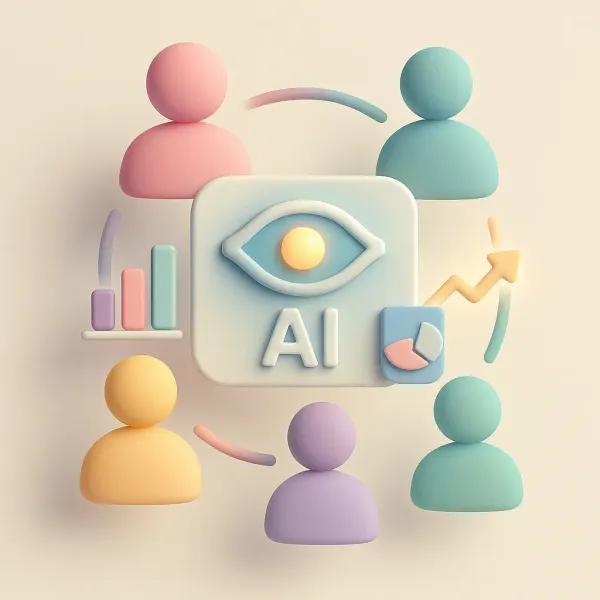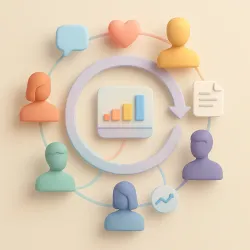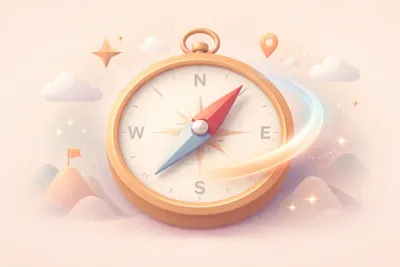The evolution of artificial intelligence in human resources has reached a critical inflection point. While we've grown accustomed to AI assistants that respond to prompts and automate basic tasks, a new paradigm is emerging that promises to fundamentally transform how HR operates. Agentic AI—autonomous systems that can plan, decide, and act with minimal human oversight—represents what many experts believe to be the most significant advancement in HR technology in recent years (Boese, 2025).
But amid the excitement and vendor promises, HR leaders face a challenging question: where is agentic AI actually ready for deployment, and where does it still fall short?
A critical reality often obscured by marketing hype: current AI agents are incapable of continuous learning from their own experiences. Unlike human employees who improve through practice and feedback, these systems require manual retraining and updating. This fundamental limitation means agentic AI works best for workflows with high structure and certainty that require medium-to-low judgment. The strategic imperative isn't to deploy AI everywhere possible—it's to focus on solving genuine business bottlenecks rather than mere inconveniences.
Understanding Agentic AI: Beyond the Chatbot
Before diving into capabilities and limitations, it's essential to understand what distinguishes agentic AI from the AI tools we've been using. Traditional AI assistants, including the generative AI chatbots that gained popularity in 2023-2024, primarily respond to human prompts. They analyze, generate content, and provide recommendations—but they wait for you to tell them what to do (Gartner, 2025).
Agentic AI operates differently. These systems can perceive their environment, make decisions autonomously, take actions on behalf of users, and achieve goals within digital settings with minimal supervision (Mercer, 2025). Rather than simply answering "What are the top candidates for this role?" an agentic AI system can identify candidates, evaluate their fit, schedule interviews, send follow-ups, handle rescheduling conflicts, and update your applicant tracking system—all without constant human direction.
The distinction lies in what researchers call "agency"—the degree of autonomy and decision-making capability an AI system possesses. Low-agency systems perform simple, specific tasks under human supervision, while high-agency systems can handle complex, adaptive tasks with greater independence (Gartner, 2025).
However, a critical limitation distinguishes even the most sophisticated AI agents from human workers: they cannot learn continuously from their own experiences. When an AI agent makes a mistake or encounters a new scenario, it doesn't naturally adapt or improve. Instead, it requires human intervention to retrain or update the underlying model. This means AI agents function more like highly capable, rule-following automations than genuinely adaptive intelligence. They excel at executing defined patterns reliably but struggle when faced with genuinely novel situations that fall outside their training.
The Adoption Landscape: Moving Fast Despite Uncertainty
The momentum behind agentic AI is undeniable. According to a May 2025 Gartner survey, 82% of HR leaders plan to implement some form of agentic AI capabilities within the next 12 months (Gartner, 2025). More strikingly, 79% of organizations report they have already adopted AI agents to some extent, with 53% currently in pilot or experimentation phases (PwC, 2025; Everest Group, 2025).
This rapid adoption is occurring despite significant knowledge gaps. When Everest Group polled HR leaders, only 22% said they fully understand the difference between traditional AI and agentic AI, while 49% admitted they "kind of know but could use a refresher" (Everest Group, 2025). This disconnect between adoption speed and understanding highlights both the perceived urgency around AI transformation and the risk of premature or misguided implementations.
The business case driving this adoption is compelling. Organizations deploying agentic AI expect substantial returns, with 62% projecting ROI above 100%, and average expectations reaching 171% (PagerDuty, 2025). Some enterprises report even more dramatic results: a 200% improvement in labor efficiency, 50% reduction in agency costs, 85% faster review processes, and 65% quicker employee onboarding (Forrester Research, 2025).
Three Critical Principles for Successful Deployment
Before diving into specific use cases, three fundamental principles should guide every agentic AI decision:
1. AI Agents Cannot Learn Continuously: Unlike human employees who improve through experience, current AI agents cannot learn from their own mistakes or adapt organically. They require manual retraining. This means they excel at executing defined patterns but don't develop judgment over time.
2. Focus on Structure, Certainty, and Low Judgment: Deploy agentic AI only in workflows with high structure (well-defined steps), high certainty (few novel situations), and medium-to-low judgment requirements (decisions based on explicit criteria). When these conditions don't hold, human involvement remains essential.
3. Solve Bottlenecks, Not Inconveniences: Focus AI deployment on genuine business constraints that significantly slow critical processes—like interview coordination consuming 40% of recruiter time. Don't waste implementation resources on minor inconveniences that annoy but don't meaningfully delay outcomes.
Example of Appropriate Use: Deploy AI to tag and classify resumes (extracting skills, experience, education into structured data). This involves high structure, high certainty, and low judgment.
Example of Inappropriate Use: Do not use AI to make hiring decisions about which candidates advance. This requires understanding cultural fit, growth potential, and subtle indicators of success—high-judgment work where human assessment remains essential.
Learn more about how data-driven HR strategies are transforming modern organizations through platforms like Happily.ai.
Where Agentic AI Is Ready: Proven Use Cases in HR
Based on current implementations and early adopter experiences, several HR domains have demonstrated readiness for agentic AI deployment:
Talent Acquisition and Recruitment
Recruitment represents the most mature application of agentic AI in HR (Newsweek, 2025). However, success depends critically on understanding where to deploy these tools versus where human judgment remains essential.
Resume Tagging and Classification (Appropriate Use): AI agents excel at extracting structured data from resumes, categorizing candidates by experience level, identifying required skills and certifications, and flagging missing information. This tagging and classification work involves high structure and low judgment—perfect conditions for agentic AI (Beam AI, 2025).
Example: An agent can scan 500 resumes and tag each one with: years of experience, education level, technical skills mentioned, industry background, and whether they meet basic requirements. This transforms an unstructured pile of resumes into organized, searchable data.
Candidate Decision-Making (Inappropriate Use): However, AI agents should not make hiring decisions or determine which candidates advance in the process. Deciding whether someone is "the right fit" requires nuanced judgment about cultural alignment, growth potential, team dynamics, and subtle indicators of success that extend beyond resume data. These high-judgment decisions remain firmly in the human domain.
The Critical Distinction: Use AI to prepare information for human decision-makers, not to replace human decision-making. The agent tags and organizes; the recruiter decides.
Interview Coordination: Agents can schedule interviews with hiring managers, send calendar invitations, provide interview prep materials to candidates, reschedule when conflicts arise, and update all stakeholders—autonomously managing the complex coordination that traditionally consumes significant recruiter time (Beam AI, 2025). This represents a genuine business bottleneck where structured workflow automation delivers immediate value.
Candidate Sourcing and Screening: Rather than requiring recruiters to manually search LinkedIn, job boards, and referral channels, sourcing agents can actively monitor inbound channels, parse profiles, and populate shortlists. However, the final evaluation of candidate quality and fit should remain with human recruiters who can assess factors beyond what appears in a profile (Beam AI, 2025).
Job Requisition Creation: Agents can guide hiring managers through the requisition process by gathering inputs, conducting compliance checks, and refining requisition details based on organizational standards—significantly reducing time to open positions (ServiceNow, 2025). This administrative bottleneck is well-suited for agentic automation.
Companies like Unilever have achieved a 70% reduction in hiring time, but notably, their AI systems assist in screening and assessment while humans make the final hiring decisions (Xenonstack, 2025). This balanced approach captures efficiency gains while maintaining human judgment where it matters most.
HR Service Delivery and Employee Support
Organizations have successfully deployed agents to handle routine HR queries and transactions—but success depends on focusing on genuine capacity bottlenecks rather than minor friction points.
High-Volume Policy and Benefits Questions (Genuine Bottleneck): When HR teams field 500+ repetitive questions per week about PTO policies, benefits enrollment, or parental leave—preventing them from strategic work—agents can interpret these questions, retrieve relevant policy information from knowledge bases, provide personalized answers based on individual circumstances, and create tickets for issues requiring human escalation (ServiceNow, 2025). This represents a true capacity constraint worth solving.
Contrast: Slightly improving the formatting of policy emails would be an inconvenience, not a bottleneck—not worth the implementation investment.
PTO and Leave Management (Administrative Bottleneck): When processing time-off requests requires multiple handoffs between employees, managers, and HR—creating delays and consuming administrative capacity—agents can process requests, check policy compliance, update systems, notify managers, and handle exceptions (Workday, 2025). This streamlines a genuine process bottleneck.
Case Management and Intelligent Triage: When employees submit hundreds of HR inquiries daily via email or portal, agents can create cases, analyze criticality, route urgent issues to human specialists, and share relevant knowledge articles for non-critical matters (ServiceNow, 2025). This intelligent triage ensures critical issues receive immediate attention while routine matters get automated resolution—solving the bottleneck of limited HR specialist capacity.
IBM's implementation of predictive agents demonstrates strategic focus on bottlenecks: their system predicts which employees are likely to leave with 95% accuracy, providing HR with proactive insights to engage and retain valuable employees (Xenonstack, 2025). Employee retention represents a genuine business constraint, making it an appropriate target for AI investment.
Onboarding and Offboarding
The structured nature of employee transitions makes them well-suited for agentic automation:
New Hire Onboarding: Agents can coordinate the multi-step onboarding process by sending pre-boarding materials, scheduling orientation sessions, tracking completion of required training and paperwork, provisioning system access, and checking in with new hires at key intervals (Workday, 2025).
Offboarding: Similarly, agents can manage the offboarding workflow by initiating exit processes, coordinating equipment returns, revoking system access, scheduling exit interviews, and ensuring compliance with final pay and benefits requirements.
These implementations show measurable results. Organizations report reducing onboarding time by 65% through agentic AI implementations (Forrester Research, 2025).
Administrative Process Automation
Many HR administrative tasks involve well-defined rules and structured data—perfect conditions for agentic AI:
Records Management: Agents can update employee records across multiple systems, ensure data consistency, flag incomplete information, and maintain compliance with data retention policies (ServiceNow, 2025).
Benefits Enrollment: During open enrollment periods, agents can answer benefits questions, guide employees through plan selection, process enrollment changes, identify employees who haven't enrolled, and send targeted reminders.
Compensation Administration: Agents can prepare compensation review packages, flag equity issues, calculate merit increases based on guidelines, and support manager decision-making with relevant market data and budget constraints.
The key enabler across these use cases is the combination of structured processes, clear decision criteria, and well-defined success metrics. As organizations measure employee engagement more effectively, they can better assess the impact of agentic AI on both efficiency and employee satisfaction.
Where Agentic AI Falls Short: Current Limitations
Despite rapid progress, significant limitations constrain agentic AI's effectiveness in several critical HR domains. Understanding these boundaries is essential for realistic planning and avoiding costly missteps.
The Continuous Learning Gap: A Fundamental Constraint
Perhaps the most critical—and least discussed—limitation of current agentic AI is its inability to learn continuously from experience. This distinguishes even sophisticated AI agents from junior human employees in fundamental ways.
When a human HR specialist handles a difficult employee situation, they learn from the experience. They internalize what worked, what didn't, and apply those insights to future situations. They get better through practice. AI agents don't. They execute their programming consistently, but they don't improve through experience without human intervention to retrain the underlying model.
This creates a paradox: agents can handle thousands of cases consistently, but each case teaches them nothing. A human might struggle with their first 50 performance reviews but excel at the next 50. An AI agent performs identically on case 1 and case 1,000—no better, no worse.
Strategic Implication: This limitation means agentic AI works best in environments with:
- High structure: Well-defined processes with clear steps and rules
- High certainty: Situations that rarely encounter genuinely novel scenarios
- Medium-to-low judgment: Decisions based primarily on explicit criteria rather than nuanced interpretation
When any of these conditions don't hold—when workflows are fluid, situations are unpredictable, or judgment is paramount—the inability to learn from experience becomes a critical weakness.
Practical Guidance: Deploy AI agents to execute reliable, repeatable patterns. Don't expect them to develop judgment, handle novel situations gracefully, or improve organically over time.
Complex Judgment and Nuanced Decision-Making
While agents excel at following defined rules and patterns, they struggle with the ambiguous, context-dependent judgments that characterize much of HR work. The inability to learn from experience compounds this limitation—agents can't develop the intuitive sense that comes from handling hundreds of nuanced situations over time.
Performance Management: Evaluating employee performance requires understanding nuanced context: personal circumstances, team dynamics, organizational changes, unwritten expectations, and subjective factors like leadership potential or cultural fit. Current agentic systems lack the contextual awareness and emotional intelligence to make these assessments reliably (Mercer, 2025). Moreover, because they cannot learn from experience, they can't develop the pattern recognition that experienced managers build over years of performance conversations.
Why This Matters: An experienced manager knows that identical performance metrics can mean very different things depending on context. An agent sees only the metrics, consistently applying the same logic regardless of circumstances it hasn't been explicitly programmed to recognize.
Conflict Resolution: Workplace conflicts involve reading between the lines, understanding power dynamics, recognizing cultural considerations, and making judgment calls about fairness and precedent. These subtleties exceed current agentic AI capabilities (McKinsey, 2025). Human mediators improve at conflict resolution through experience; AI agents execute the same approach regardless of what they've encountered before.
Career Development Guidance: While agents can recommend training based on skills gaps, truly effective career guidance requires understanding an individual's values, aspirations, constraints, and the often-unspoken politics of organizational advancement. This remains a fundamentally human conversation. An AI cannot learn that "this type of person typically thrives in this environment" through accumulated experience—it can only follow explicit rules.
Hiring Decisions: This is why agents should tag and classify resumes but not decide which candidates to advance. The decision about who will succeed in a role involves judgment about factors that extend beyond structured data: energy in conversation, thoughtfulness in responses, alignment with team culture, potential for growth. Humans develop better hiring instincts through experience; AI agents don't.
Sensitive Employee Issues: Situations involving mental health, harassment, discrimination, personal crises, or legal matters demand human judgment, empathy, and accountability that AI agents cannot provide (Gartner, 2025). These situations also require the ability to learn from mistakes—something agents fundamentally cannot do.
As researchers note, "As agents take over critical decision-making processes, we risk losing the nuanced perspectives that make organizations resilient and adaptable" (HRKatha, 2025). The data-driven insights AI provides come at the cost of human elements—intuition, creativity, and trust—that foster innovation and adaptive problem-solving.
The Cost of Misapplying Agentic AI
What happens when organizations deploy agentic AI in inappropriate contexts—ignoring the structure, certainty, and judgment requirements? The consequences extend beyond technical failure:
Example: AI-Driven Performance Decisions: Some organizations have attempted to use AI agents to make or heavily influence performance ratings and compensation decisions. Because performance contexts vary significantly (team dynamics, organizational changes, individual circumstances), certainty is low. Because evaluating performance requires nuanced judgment, the judgment requirement is high. These conditions make agentic AI inappropriate—yet the allure of "objective, data-driven decisions" tempts deployment anyway.
The Result: Employees feel reduced to metrics. Managers lose trust in the system when they know the AI can't see crucial context. High performers in difficult situations get unfairly penalized. The organization loses the adaptive, contextual judgment that effective performance management requires.
Example: Automated Candidate Rejection: Organizations deploying AI to make rejection decisions (not just classify candidates) face similar problems. Hiring decisions require judgment about cultural fit, growth potential, and subtle indicators of success. When agents make these calls automatically, promising candidates get rejected for factors the AI overweights, diversity suffers as historical biases get encoded at scale, and the organization loses the human judgment that identifies potential beyond resume data.
The Hidden Cost: Beyond individual misjudgments, inappropriate AI deployment damages trust. When employees believe AI makes important decisions about their careers without understanding their circumstances, engagement drops. When candidates receive impersonal AI rejections for reasons they don't understand, employer brand suffers.
Why This Matters: The inability to learn from experience means these problems don't self-correct. A human hiring manager who makes a bad decision can learn from it. An AI agent making bad decisions will continue making them until humans intervene to retrain the model—often after significant damage has occurred.
The Prevention: Rigorously apply the structure-certainty-judgment framework before any deployment. When in doubt, use AI to prepare information for human decision-makers rather than replace human judgment entirely.
Unstructured and Evolving Processes
Many HR activities lack the predictable structure that enables effective agentic AI:
Organizational Design: Decisions about reporting structures, team composition, role definition, and organizational culture require strategic thinking about multiple interdependent factors, long-term implications, and alignment with business direction. These complex, one-off decisions don't fit agentic AI's pattern-recognition strengths.
Change Management: Guiding organizations through transformations demands reading organizational mood, identifying informal influencers, adapting communication strategies in real-time, and making situational judgments about timing and approach—capabilities that remain distinctly human.
Strategic Workforce Planning: While agents can analyze workforce data and identify trends, effective workforce planning requires synthesizing information about business strategy, market shifts, competitor moves, technology disruption, and cultural evolution. This strategic synthesis remains beyond current agentic capabilities.
Culture Building: Despite sophisticated analytics, creating and sustaining organizational culture requires authentic human connection, symbolic leadership, storytelling, and relationship-building that AI cannot replicate. Tools like Happily.ai can measure and track culture, but building it remains a human endeavor.
Data Quality and Integration Challenges
Agentic AI systems require high-quality, well-integrated data to function effectively. Many organizations face significant gaps:
Fragmented Data: HR data often resides in multiple disconnected systems—HRIS, ATS, LMS, payroll, performance management platforms. Agents struggle to function across these silos without robust integration (Everest Group, 2025).
Outdated Information: One implementation discovered their agent was providing COVID-related policies that were no longer relevant. Keeping knowledge bases current requires ongoing human curation (McKinsey, 2025).
Inconsistent Data Quality: Missing fields, duplicate records, inconsistent formats, and data entry errors undermine agent effectiveness. Organizations must invest in data cleanup and governance before agentic AI can deliver value.
Privacy and Security Concerns: 53% of companies confirm their AI agents access sensitive employee data, with 58% reporting daily access (Masterofcode, 2025). This raises significant concerns about data security, privacy violations, and compliance with regulations like GDPR.
Ethical and Bias Risks
The autonomous nature of agentic AI amplifies risks around fairness and discrimination:
Amplified Bias: While agents can process more candidates than human recruiters, they may also amplify historical biases present in training data—potentially creating discrimination at scale (HBR, 2025).
Lack of Transparency: The decision-making processes of complex AI agents can be opaque, making it difficult to identify why certain candidates were rejected or employees received specific recommendations. This "black box" problem creates legal and ethical vulnerabilities.
Accountability Gaps: When an agent makes a problematic decision, who is responsible? The ambiguity around accountability for autonomous AI actions poses significant legal and ethical challenges (HBR, 2025).
Organizations must implement robust governance frameworks, including regular bias audits, human oversight for high-stakes decisions, clear escalation protocols, and mechanisms for employees to understand and challenge AI-driven decisions.
Cost and Complexity
Despite ROI projections, implementation challenges create significant barriers:
High Initial Investment: Building or deploying agentic AI requires investment in technology platforms, data integration, process redesign, training, and ongoing tuning. For many organizations, these costs are prohibitive (Gartner, 2025).
Skills Gap: Organizations face significant shortages of talent capable of designing, implementing, and managing agentic systems. By 2028, despite some easing, 44% of leaders still expect 20-40% gaps in AI-critical roles like agentic workflow design and human-AI collaboration specialists (World Economic Forum, 2025).
Complexity at Scale: While single agents may be straightforward, multi-agent systems that coordinate across complex workflows introduce significant implementation challenges. Despite vendor enthusiasm, enterprise adoption of multi-agent systems remains limited (Gartner, 2025).
Project Failure Risk: Gartner projects that over 40% of AI agent projects will be canceled by the end of 2027 due to escalating costs, unclear business value, or inadequate risk controls (Gartner, 2025). Many current implementations are pilot projects that may never reach production scale.
These limitations don't negate agentic AI's potential, but they demand realistic expectations and careful planning. As one analyst notes, "The challenges go beyond the workplace. They raise serious ethical and societal questions that companies can no longer afford to ignore" (HRKatha, 2025).
Implementation Considerations: Getting Agentic AI Right
For HR leaders ready to explore agentic AI, several critical success factors emerge from early implementations:
Start with Clear Business Problems
Avoid "shiny object syndrome" by leading with specific problems you're trying to solve rather than technology capabilities (Mercer, 2025). The most successful implementations begin with well-defined use cases that deliver quick wins—like automating common HR queries—before expanding to more complex applications (Xenonstack, 2025).
Focus on Bottlenecks, Not Inconveniences
A critical strategic distinction separates successful agentic AI deployments from disappointing ones: solving genuine business bottlenecks versus addressing minor inconveniences.
Business Bottlenecks are constraints that:
- Significantly slow down critical processes
- Create delays that cascade across the organization
- Require multiple people to stop work and coordinate
- Scale poorly as the organization grows
- Directly impact time-to-hire, employee satisfaction, or compliance risk
Examples of bottlenecks worth solving:
- Recruiters spending 40% of their time scheduling interviews (coordination bottleneck)
- Open positions sitting empty for weeks waiting for requisition approvals (approval bottleneck)
- New hires waiting days for answers to benefits questions (information access bottleneck)
- HR team overwhelmed by 500 policy questions per week preventing strategic work (capacity bottleneck)
Inconveniences are minor friction points that:
- Annoy people but don't significantly delay outcomes
- Affect individuals rather than systemic workflows
- Already have acceptable workarounds
- Won't deliver meaningful ROI even if solved
Examples of inconveniences not worth solving (yet):
- Making it slightly easier to access org charts
- Automating a task that takes 2 minutes per week
- Improving the formatting of automatically generated emails
- Streamlining a process that only 5 people use monthly
The implementation and ongoing maintenance costs of agentic AI are substantial. Spending those resources on inconveniences wastes budget and attention that should focus on genuine constraints holding back organizational performance.
Diagnostic Questions:
- If we solve this problem, will it meaningfully accelerate a critical business process?
- Does this problem currently require significant manual effort from multiple people?
- Is this problem preventing us from achieving important business goals?
- Will solving this create capacity for higher-value work?
If you can't answer "yes" to at least two of these questions, you're likely looking at an inconvenience rather than a bottleneck. Move on to more impactful use cases.
Additional Questions to Ask:
- What repetitive, high-volume tasks consume significant HR time?
- Where do delays in our HR processes create bottlenecks or frustration?
- Which processes have clear rules, structured data, and measurable outcomes?
- What level of autonomy and risk are we comfortable with?
Build Strong Foundations
Agentic AI requires robust underlying infrastructure:
Data Integration: Agents need access to unified, accurate data across your HR tech stack. This often requires significant integration work before agent deployment.
Knowledge Management: Agents rely on up-to-date knowledge bases. You need processes for continuously curating and validating the information agents use (McKinsey, 2025).
Process Documentation: Agents work best when processes are clearly documented. Attempting to "agentize" poorly defined or inconsistent processes typically fails.
Governance Framework: Establish clear policies around data access, decision authority, human escalation triggers, bias monitoring, and compliance requirements before deployment (HBR, 2025).
Understanding leading vs. lagging indicators can help you identify the right metrics to track agentic AI effectiveness and impact on organizational performance.
Apply the Structure-Certainty-Judgment Framework
Before deploying any agentic AI solution, evaluate the use case against three critical dimensions:
1. Process Structure (High Structure Required)
- Are the steps in this process clearly defined and consistent?
- Can we document exactly what should happen in most cases?
- Do exceptions follow predictable patterns?
✅ Good fit: Resume tagging (always extract same fields), PTO request processing (clear approval rules), benefits enrollment (defined steps and options)
❌ Poor fit: Organizational restructuring (every situation unique), culture building (emergent and adaptive), strategic workforce planning (requires synthesis of many ambiguous inputs)
2. Environmental Certainty (High Certainty Required)
- Does this process encounter genuinely novel situations rarely?
- Can we anticipate most scenarios the agent will face?
- Is the underlying context stable over time?
✅ Good fit: Interview scheduling (limited variation), policy question answering (stable policy documentation), onboarding task coordination (repeatable process)
❌ Poor fit: Crisis response (inherently unpredictable), market-driven compensation decisions (constantly shifting context), emerging technology skill assessment (rapidly evolving domain)
3. Judgment Level (Low-to-Medium Judgment Required)
- Can decisions be made primarily using explicit criteria?
- Would two trained HR professionals reach similar conclusions most of the time?
- Are we comfortable with consistent but imperfect decisions?
✅ Good fit: Checking if a resume meets minimum requirements (explicit criteria), flagging incomplete forms (clear rules), categorizing inquiry types (learnable patterns)
❌ Poor fit: Evaluating cultural fit (highly subjective), determining promotion readiness (requires nuanced assessment), resolving interpersonal conflicts (requires situational judgment)
Decision Matrix:
| Use Case | Structure | Certainty | Judgment | AI Suitability |
|---|---|---|---|---|
| Resume tagging | High | High | Low | ✅ Excellent |
| Hiring decisions | Medium | Medium | High | ❌ Inappropriate |
| Interview scheduling | High | High | Low | ✅ Excellent |
| Performance evaluation | Low | Medium | High | ❌ Inappropriate |
| Policy Q&A | High | High | Medium | ✅ Good |
| Career counseling | Low | Low | High | ❌ Inappropriate |
| Benefits enrollment | High | High | Low | ✅ Excellent |
| Conflict mediation | Low | Low | High | ❌ Inappropriate |
Critical Principle: All three dimensions should favor AI use. If any dimension is unfavorable, human involvement is essential. When in doubt, use AI to support human decision-making (by organizing information, flagging issues, preparing analysis) rather than replace it (by making final decisions).
Adopt a Phased Approach
Organizations achieving the strongest results build agent capabilities progressively:
- Phase 0 (Preparation): Assess readiness, secure stakeholder alignment, address data quality issues, and identify pilot use cases
- Phase 1 (Pilot): Deploy single agents for specific, well-defined tasks to build confidence and understand ROI
- Phase 2 (Multi-function Scaling): Expand successful agents to additional functions and begin coordinating multiple agents
- Phase 3 (Transformation): Integrate agents deeply into core workflows and organizational design
According to Everest Group, 53% of organizations are currently in Phase 1, 21% in Phase 2, and only 3% have reached Phase 3 transformation-level integration (Everest Group, 2025). This distribution reflects both the early stage of adoption and the difficulty of scaling beyond initial pilots.
Maintain Human Oversight
Even well-designed agents require appropriate human involvement:
Critical Decision Points: Maintain human review for decisions with significant employee impact—hiring, termination, compensation, sensitive cases (Gartner, 2025).
Exception Handling: Design agents to recognize when situations fall outside their training and escalate to human judgment (Workday, 2025).
Continuous Monitoring: Regularly review agent decisions for bias, errors, and unintended consequences. Two-thirds of HR leaders trust AI agents to benefit employee experience, but trust must be validated through ongoing monitoring (Gartner, 2025).
Governance Capacity: Human oversight capacity can become a bottleneck. Organizations must plan for the governance resources needed to manage agent operations effectively (McKinsey, 2025).
Invest in Change Management
Technology alone doesn't create transformation. Organizations must:
Redesign Work: Moving to agentic AI requires rethinking roles, responsibilities, and workflows. Many employees will shift from executing tasks to designing, managing, and improving agentic systems (McKinsey, 2025).
Reskill the Workforce: HR teams need new capabilities in areas like prompt engineering, agentic workflow design, AI governance, and human-AI collaboration (World Economic Forum, 2025). Organizations face significant gaps in these skills that must be addressed through training and hiring.
Communicate Transparently: Agentic AI raises legitimate concerns about job displacement. Leaders must communicate honestly about impacts while helping employees see how AI can augment rather than replace their work. Even positive change can harm trust, engagement, and productivity without clear communication (Mercer, 2025).
Foster Learning Culture: Organizations where employees embrace AI tools as learning partners rather than threats achieve better outcomes. This requires creating environments where experimentation is encouraged and growth is expected (Absorb Software, 2025).
Effective communication strategies and continuous feedback become even more critical during AI transformation.
Choose the Right Partners
Given the complexity and rapid evolution of agentic AI, partner selection matters enormously:
Evaluate Real Capabilities: Be wary of "agent washing"—vendors rebranding existing chatbots and RPA tools as agents without substantial agentic functionality (Gartner, 2025). Ask for specific examples of autonomous decision-making and multi-step workflow execution.
Assess Integration: Solutions that can't integrate with your existing HR tech stack will create more problems than they solve. Prioritize platforms with robust APIs and proven integration capabilities.
Understand the Build vs. Buy Decision: 42% of organizations prefer partnering with enterprise HR platforms to build agentic capabilities, while 32% favor specialized AI providers (Everest Group, 2025). The specificity and complexity of some use cases may require developing agent capabilities in-house.
Evaluate Governance Features: Look for solutions with built-in bias detection, audit trails, human override capabilities, and compliance support.
Leading HR platforms like Oracle, SAP SuccessFactors, Workday, and ServiceNow have introduced agentic AI capabilities into their systems (HR Executive, 2025), offering the advantage of integration with existing HR infrastructure.
The Workforce Impact: Navigating Displacement and Opportunity
One of the most challenging aspects of agentic AI involves its impact on HR roles and the broader workforce. Projections vary, but the potential disruption is significant.
Scale of Impact
Research suggests substantial workforce changes ahead:
- HR leaders project agentic AI could replace an average of 9% of their organization's workforce within two years (Gartner, 2025)
- By 2030, Gartner estimates 50% of current HR activities will be AI-automated or performed by AI agents (Gartner, 2025)
- Half of leaders already report 10-20% overcapacity due to automation, with expectations of 30-39% excess capacity by 2028 (World Economic Forum, 2025)
Functions at highest risk include customer support, back-office operations, transactional finance, and administrative roles (World Economic Forum, 2025). Within HR, routine transactional work is most vulnerable to agentic automation.
Creating New Opportunities
Alongside displacement, agentic AI creates new roles and capabilities:
Agent Supervisors: Professionals who direct AI agents, set objectives, and ensure quality outcomes
Workflow Designers: Specialists who analyze processes, identify automation opportunities, and design effective agentic workflows
AI-Augmented HR Specialists: HR professionals who leverage AI tools to handle more complex, higher-value work
AI Governance Specialists: Roles focused on ensuring ethical, compliant, and effective AI deployment
54% of AI pioneers report that AI is helping them contribute more strategic value (Workday, 2025). When agents handle routine work, HR professionals can focus on relationship-building, strategic advising, and complex problem-solving.
Responsible Transition Strategies
Organizations must manage this transition thoughtfully:
Portfolio Approach: Combine redeployment, attrition, reskilling, cross-training, hiring freezes, and selective recruitment to manage workforce changes with minimal disruption (World Economic Forum, 2025).
Reskilling Investments: Provide employees with opportunities to develop skills in areas where humans retain advantages—creativity, empathy, ethical judgment, strategic thinking, and complex problem-solving.
Internal Mobility: Use AI-powered talent marketplaces to match displaced employees with new opportunities within the organization.
Transparent Communication: Employees deserve honest information about how AI will affect their roles, what support will be available, and what opportunities exist for growth and transition.
BMW's approach offers a model: as they deployed their AIconic multi-agent system, they paired technology adoption with workforce empowerment, providing digital training and AI innovation spaces for employees at all levels (World Economic Forum, 2025).
The question isn't whether to adopt agentic AI—competitive pressure makes adoption likely inevitable—but how to do so in ways that maximize value while treating people with dignity and investing in their continued development.
Looking Ahead: The Future of Agentic AI in HR
As we move through 2025 and beyond, several trends will shape agentic AI's evolution in HR:
Increasing Sophistication (Within Fundamental Constraints)
AI capabilities continue advancing rapidly. The length of tasks AI can reliably complete doubled approximately every seven months from 2019-2024, accelerating to every four months more recently, reaching roughly two hours as of late 2025 (METR, 2025). If this trajectory continues, AI systems could potentially complete four days of work without supervision by 2027—representing a fundamental shift from intern-level to senior-level autonomous capability.
However: This increasing sophistication doesn't necessarily solve the continuous learning limitation. Even agents capable of completing multi-day tasks may still lack the ability to learn from their own experiences without human retraining. This means longer task completion without changing the fundamental constraint: agents execute patterns reliably but don't develop judgment through practice.
Implication: Future agents may handle more complex, multi-step workflows while still requiring careful limitation to high-structure, high-certainty contexts. The sophistication increases, but the need for rigorous evaluation of appropriateness remains.
Multi-Agent Orchestration
Current implementations focus largely on single-purpose agents. The future involves multi-agent systems where specialized agents collaborate across complex workflows. For example, a talent acquisition agent might coordinate with onboarding agents, IT provisioning agents, and facility management agents to deliver seamless new hire experiences (Gartner, 2025).
Human-AI Hybrid Teams
Organizations will increasingly think about their workforce as comprising both human employees and AI agents. Some pioneering companies already express org charts not only in FTEs but also in number of agents deployed across the organization (McKinsey, 2025). This evolution will require new approaches to workforce planning, performance management, and organizational design.
Agent Management Infrastructure
Just as organizations use HRIS to manage human employees, they'll need "agent systems of record" to manage their AI workforce—tracking agent capabilities, assignments, performance, access rights, and compliance (Mercer, 2025). Vendors like Workday have already introduced such systems (Workday, 2025).
Enhanced Governance and Regulation
As agentic AI becomes more prevalent, expect increased regulatory attention to issues of bias, transparency, accountability, and worker displacement. Organizations that build strong governance now will be better positioned for future compliance requirements.
Integration with Organizational Culture
The most successful implementations won't just add AI to existing operations—they'll fundamentally rethink how work gets done. This requires alignment with organizational culture and values, ensuring AI augments human capability rather than undermining the elements of culture that drive performance.
Platforms like Happily.ai will play an increasingly important role in measuring culture and ensuring that AI implementations support rather than undermine the human elements that make organizations thrive.
Conclusion: Navigating the Agentic Era Thoughtfully
Agentic AI represents a genuine inflection point in HR technology—not just another incremental improvement, but a fundamental shift in how certain types of work get done. The technology has matured to the point where specific use cases in recruitment support, employee service delivery, onboarding coordination, and administrative process automation are delivering measurable value today.
Yet critical limitations demand respect and shape appropriate deployment. Current AI agents cannot learn from experience—they execute patterns reliably but don't develop judgment or adapt organically. This fundamental constraint means agentic AI works best in workflows with high structure, high certainty, and low-to-medium judgment requirements.
The strategic imperative isn't to deploy AI everywhere possible—it's to focus on genuine business bottlenecks that constrain organizational performance. Interview coordination that consumes 40% of recruiter time? Excellent use case. A slight formatting improvement in generated emails? Not worth the implementation cost.
Remember the critical distinction: Use AI agents to tag and classify (resume data extraction, inquiry categorization, compliance checking) but not to decide (hiring selections, performance evaluations, career guidance). Preparation for human decision-making: appropriate. Replacement of human judgment: inappropriate.
The path forward requires balancing optimism about AI's potential with realistic assessment of its limitations:
Where to Deploy:
- High-volume, repeatable workflows that follow consistent patterns
- Administrative bottlenecks where coordination consumes valuable time
- Information access challenges that delay decisions
- Structured processes where consistency delivers more value than adaptation
Where Humans Remain Essential:
- High-judgment decisions about people's careers and opportunities
- Situations requiring contextual understanding and emotional intelligence
- Strategic choices involving ambiguity and competing considerations
- Any scenario where continuous learning from experience matters
Success comes from thoughtfully integrating AI into your culture, values, and operating model in ways that enhance—rather than diminish—the human elements that make great HR organizations great. Build the data, process, and governance foundations that enable effective deployment. Maintain appropriate human oversight, especially for high-stakes decisions. Invest in reskilling your workforce and redesigning work to leverage the complementary strengths of humans and AI agents.
Most importantly, approach agentic AI with clear-eyed pragmatism. It's a powerful tool for solving specific types of problems—not a universal solution for every HR challenge. Those who navigate this transition thoughtfully, focusing on real bottlenecks and maintaining human judgment where it matters, will create genuine competitive advantage. Those who rush to deploy AI without understanding its fundamental limitations risk costly failures and missed opportunities.
The agentic era is here. The question for HR leaders isn't whether to engage with this technology, but how to do so strategically, focusing resources on high-impact bottlenecks while preserving human judgment for the decisions that truly require it.
Ready to measure the impact of your AI and HR initiatives? Happily.ai provides real-time analytics and behavioral insights that help you understand what's working—and what's not—as you navigate the future of HR. Learn more about our people analytics platform and how we're helping organizations build thriving cultures in the age of AI.
References
Beam AI. (2025). Agentic AI in HR: Use cases, implementation, and what's changing in 2025. Retrieved from https://beam.ai/agentic-insights/agentic-ai-in-hr-use-cases-implementation-and-what-s-changing-in-2025
Boese, S. (2025). Agentic AI: What HR must know about the next evolution of HR tech. HR Executive.
Everest Group. (2025). From automation to agency: Why agentic AI is a new era for HR tech. Retrieved from https://www.unleash.ai/unleash-world/from-automation-to-agency-why-agentic-ai-is-a-new-era-for-hr-tech/
Forrester Research. (2025). ROI for generative AI and agentic AI implementations. Writer.com.
Gartner. (2025). Agentic AI in HR: Unpacking the hype and addressing the uncertainty. HR Executive.
Harvard Business Review (HBR). (2025). Organizations aren't ready for the risks of agentic AI.
Harvard Business Review (HBR). (2025). Agentic AI is already changing the workforce.
HRKatha. (2025). 2025 workplace trends: Why agentic AI threatens our job.
Masterofcode. (2025). 150+ AI agent statistics [July 2025].
McKinsey. (2025). Building and managing an agentic AI workforce. Retrieved from https://www.mckinsey.com/capabilities/people-and-organizational-performance/our-insights/the-future-of-work-is-agentic
McKinsey. (2025). The agentic organization: Contours of the next paradigm for the AI era.
Mercer. (2025). Defining tech in 2025—AI agents. Retrieved from https://www.mercer.com/insights/people-strategy/hr-transformation/heads-up-hr-2025-is-the-year-of-agentic-ai/
METR. (2025). Measuring AI ability to complete long tasks.
Newsweek. (2025). AI agents most mature in recruiting applications.
PagerDuty. (2025). Agentic AI ROI research and projections.
PwC. (2025). 2025 survey of U.S. business leaders on AI adoption.
ServiceNow. (2025). Agentic AI capabilities for HR. Community Blog.
Workday. (2025). AI agents for HR: Top use cases and examples. Retrieved from https://blog.workday.com/en-us/ai-agents-for-hr-top-use-cases-and-examples.html
World Economic Forum. (2025). How we can balance AI overcapacity and talent shortages.
Xenonstack. (2025). Streamlining human resources with agentic AI and agents. Retrieved from https://www.xenonstack.com/blog/agentic-ai-human-resource-management









